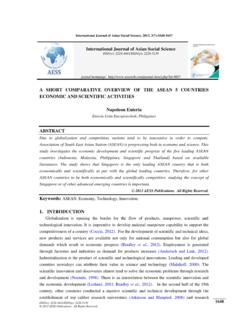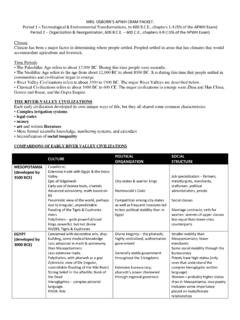Transcription of HISTORY OF TECHNOLOGICAL HAZARDS, DISASTERS AND …
1 UNESCO EOLSSSAMPLE CHAPTERSWORLD ENVIRONMENTAL HISTORY - HISTORY of TECHNOLOGICAL hazards , DISASTERS and Accidents - Gianni Silei Encyclopedia of Life Support Systems (EOLSS) HISTORY OF TECHNOLOGICAL hazards , DISASTERS AND ACCIDENTS Gianni Silei Department of Historical, Law, Political and Social Sciences, University of Siena Keywords: HISTORY , TECHNOLOGICAL hazards , DISASTERS , Catastrophes, Accidents, Risk, Environment. Contents 1. Introduction 2. From the nineteenth to the early twentieth century 3. The first post-war years 4. The second post-war years 5. From 1970s to the present day Glossary Bibliography Biographical Sketch Summary Although some TECHNOLOGICAL risks can be traced back to the ancient times, it was between the nineteenth and the beginning of the twentieth century that technical advancement and the process of industrialization posed the question of the management of the technologies and of their possible disastrous consequences.
2 During these years there was an important change in approaching these issues: from the inevitability of DISASTERS to the adoption of policies of prevention and risk management. This important change had as a consequence an increasing role of public institutions (national governments, agencies and authorities) in the control, prevention and emergency management of TECHNOLOGICAL DISASTERS . According to this new approach, scientists, the experts and the technicians that were required to predict using their special knowledge TECHNOLOGICAL DISASTERS , became central figures.
3 The first post-war period represents an important turning point because this new and modern attitude towards TECHNOLOGICAL hazards reached its full maturity. The spreading of new technologies also facilitated by the process of industrialization and the emergence of the era of mass consumptions, influenced a new discipline that, from different approaches, tried to address and resolve the various aspects of TECHNOLOGICAL threats. Born in the postwar period, the disastrology and in general policies to ensure safety, found a systematic application after the Second World War.
4 The increasing complexity of certain technologies used in industry, in the production of energy, in the transport sector and especially the potentially catastrophic consequences of TECHNOLOGICAL accidents, imposed an additional effort in the field of regulation, prevention and management of emergencies. In some cases, such as the atomic energy for civilian use, UNESCO EOLSSSAMPLE CHAPTERSWORLD ENVIRONMENTAL HISTORY - HISTORY of TECHNOLOGICAL hazards , DISASTERS and Accidents - Gianni Silei Encyclopedia of Life Support Systems (EOLSS) an increasing role was played by national and international agencies that were created during this period.
5 Since the 1970s but especially in the following decade, several major accidents (Three Mile Island, Seveso, Bhopal, Chernobyl, the environmental DISASTERS caused by oil tankers) put forward the need for a standardization of rules and a greater international co-operation. The globalization of TECHNOLOGICAL hazards at the time of the so-called risk society has fostered a more interdisciplinary approach to the issues of TECHNOLOGICAL DISASTERS . Moreover, the increased number of new hazardous substances and materials and the opportunities for human error inherent their use has determined an escalation of TECHNOLOGICAL accidents.
6 All this factors and the more and more unstable boundaries between natural DISASTERS and man-made DISASTERS has necessarily imposed growing efforts for harmonization policies at a national and an international level to ensure collective security, public health and environmental protection. 1. Introduction There is not a universal definition of TECHNOLOGICAL hazards and accidents. Even though some studies emphasize the complexity of the issue of individual responsibility in TECHNOLOGICAL DISASTERS , literature has commonly accepted a distinction between natural hazards (acts of god) and man-made (acts of man) hazards .
7 According to some classifications natural hazards are threats determined by uncontrollable events, while man-made hazards are threats determined by artificial ( TECHNOLOGICAL ) factors. Natural hazards can be defined as those elements of the physical environment, harmful to man and caused by forces extraneous to him . The term natural hazards refers to all atmospheric, hydrologic, geologic (especially seismic and volcanic), and wildfire phenomena, while the term man-made hazards refers to artificial phenomena caused by human action, inaction, negligence or error.
8 These phenomena are also defined as TECHNOLOGICAL hazards when determined by a technology ( industrial, engineering, transportation) and as sociological hazards when they have a direct human motivation ( crime, riots, conflicts). As threat and potential danger, hazards are strictly connected to concepts of risk, disaster and catastrophe. The term risk (from the ancient Italian risicare) indicates the possibility of suffering a harmful event or loss or danger. While a risk involves uncertainty, a disaster (from the Italian disastro, literally unfavorable to one s stars ) is an unexpected natural or man-made event with harmful but temporary consequences.
9 DISASTERS can be defined as the result of an extreme event that significantly disrupts the workings of a community. A disaster is a tragic situations over which persons, groups, or communities have no control-situations which are imposed by an outside force too great to resist . This kind of events may have as a consequence deaths, material destructions and severe economic damages but can also determine situations of collective stress in a community and bring to the test the level of vulnerability of a society. Some interpretations consider a disaster UNESCO EOLSSSAMPLE CHAPTERSWORLD ENVIRONMENTAL HISTORY - HISTORY of TECHNOLOGICAL hazards , DISASTERS and Accidents - Gianni Silei Encyclopedia of Life Support Systems (EOLSS) a consequence of peculiar social conditions, some others, consider man-made DISASTERS mainly as socio-technical problems, as the product of a failure of foresight and a combination of technical, social and even institutional and administrative factors.
10 The Normal accident Theory argues that the combination of high complexity and tight coupling must lead to failures. According to this theory, that has been integrated, empirically tested and verified, TECHNOLOGICAL accidents are inevitable and happen all of the time; serious ones are inevitable but infrequent; catastrophes are inevitable but extremely rare . Since the mid-1980s, starting with an approach opposite to that of the Normal accident Theory, some researchers developed the High Reliability Theory, which says that is possible to create highly reliable systems capable of ensuring almost absolute security levels.
















